Biography
Interests
Arrey Oben Ebob Ashu1, Tiepma Ngongang Eurydice Flore1, Bernard Tiencheu1*, Aduni Ufuan Achidi1, Mbame Efeti Claudine1, Noel Tenyang2 & Feumba Dibamda Romelle1
1Department of Biochemistry and Molecular Biology, Faculty of Science, University of Buea, Buea, Cameroon
2Department of Biological Science, Faculty of Science, University of Maroua, Maroua, Cameroon
*Correspondence to: Dr. Bernard Tiencheu, Department of Biochemistry and Molecular Biology, Faculty of Science, University of Buea, Buea, Cameroon.
Copyright © 2021 Dr. Bernard Tiencheu, et al. This is an open access article distributed under the Creative Commons Attribution License, which permits unrestricted use, distribution, and reproduction in any medium, provided the original work is properly cited.
Abstract
Mothers and caregivers typically feed infants according to their culture, purchase power and level of awareness with no due diligence to nutritional quality of the diet. Scientific evidence on nutritional adequacy of predominant complementary foods is critical for planning and prioritizing interventions. The purpose of the current study was to evaluate the quality of complementary foods. Some complementary food types Vita Force (VT), Soytine (ST), Soyaconia (SC), Soya Pap (SP), Tanty Reine (TR), Phospatine, Dina Baby (DB), were assayed for proximate composition, energy and micronutrients using standard method of AOAC, (2005) [1]. Adequacy of the complementary foods in nutrients for complementary feeding purposes was assessed as a ratio between actual composition and recommended composition of complementary foods. Microbiological analysis was done using standard methods of olurunjuwon et al., (2014) [2]. Data obtained was statistical analyzed using GraphPad insta 3. The results for the proximate analysis (carbohydrate, protein, fat, ash, fibre) of the complementary food samples were comparatively lower than the recommendation by FAO (2006) [3]. Micronutrient content of the weaning foods as well as the functional properties was significantly different from that of the standard. Mineral composition showed that none of the different weaning foods had the recommended value for the minerals Ca, Na, K, Fe, Zn, Mg except for one of the semi-scaled CF Tanty which had the right amount (48.6%) of Mg mineral. Microbiological load for weaning foods determines the wholesomeness of weaning foods for consumption as the Coliform counts were in acceptable range (less than 3cfu/g) but homemade food samples like kwacoco and pap had higher value for total bacterial count of 200cfu/g. Hence, most of the weaning foods sold in Fako, South West region of Cameroon are not adequate for children’s normal nutrition and growth.
Introduction
Exclusively, breast feeding for the first 6 months is the world health organization (WHO)’s recommended
method of feeding full-term infants by healthy, well-nourished mothers. However, after 6 months’ breast
milk alone is not sufficient both in quantity and in quality to meet the nutritional requirements of the child
(Kalanda et al., 2006). Adequate foods known as complementary foods need to be introduced, which begins
with liquid foods and gently move up to solid foods; this is the weaning process. Weaning is when foods
other than breast milk are given to infant’s diet while gradually reducing breastfeeding (WHO, 2014). The
introduction of weaning foods is often accompanied by stress and ill health for infants in developing countries
mostly because the foods are not properly tailored to the infant’s needs [4]. Many traditional weaning foods
in Africa are only a slight modification of adult food involving only mashing and dilution without taking into
consideration the special nutritional requirements of young children. Adults diet especially in developing
countries, consist of highly starchy staples and unless properly modified, unsuitable for infants and young
children with their small gastric capacities [5]. However, during the process of complementary feeding,
children need foods that are not strong, hygienic, energy and nutrient-dense to reach their high nutritional
requirement (WHO, 2013). Complementary foods in third world countries are mostly prepared under non
sterile environments using water from un-hygienic sources thus making the child vulnerable to weaning
diarrhea which causes a dilemma to both mother and infant; to wean or not to wean, which is termed the
weaning’s dilemma [6]. Therefore, the aim of this work which is to evaluate the adequacy of complementary
foods sold in the South West region of Cameroon.
Material and Methods
Some locally produced baby foods like Sweet potato custard, Banana custard, Soyaconia (SC), Bionutri,
Tanty Reine (TR) and Dina Baby (DB) were purchased from local stores in Buea, Mutengene and Limbe
in the South West Region of Cameroon. A standard (Phosphatine) a commercially sold baby food was
obtained from a super market and used as a control.the samples were packed and sealed in polyethylene
bags at ambient temperature (26 ± 2ºC), transported directly to the laboratory stored in the refrigerator until
further analysis.
The yeast, coliform and bacterial loads were analyzed using the Sabouraud dextrose agar, violet red bile
lactose agar and plate count agar media respectively [2].
Sabouraud Dextrose agar (SDA) (4.2g) was dissolved in 100ml of distilled water. It was autoclaved at121°C
for 1hour in an electric pressure steam sterilizer (model No.25X) and allowed to cool to about 45°C. The
work environment was sterilized with 70% alcohol. 1ml of each sample was diluted in 9ml of water and 1ml
of the diluted samples poured into labeled petri-dishes with the use of a micropipette (Gilson Pipetman,
060087N). Then 10ml of the medium (SDA) was put into a petri-dish and shaken gently to mix with the
sample. This solidified and formed a gel in the petri dishes. They were then incubated (DHP-9050) at 37°C
for 24 hours. After 24 hours, the total yeasts were counted as colony forming units (CFU) [2].
Plate count agar (PCA) (2.4g) was diluted in 100ml of distilled water. It is autoclaved at 121°C for 1 hour
in a sterilizer (model No.25X) and left to cool to about 45°C.The working space was sterilized with 70%
alcohol. For every sample, 1ml was diluted in 9ml of water and 1ml of the diluted samples poured into
labeled petri-dishes using a micropipette (Gilson Pipetman, 060087N). Then 10ml of the medium (PCA)
was put into the petri dish and shaken gently to mix with the sample. This molded and produced a gel in the
petri dish. It was then incubated (DHP-9050) at 37°C for 24 hours. After 24 hours, the total bacteria load
was expressed as colony forming units (CFU) [2].
Violet red agar (6.2g) was dissolved in 150ml of distilled water. This solution was allowed to boil while
shaking over a bunsen burner flame until it was completely dissolved. It was then allowed to cool to about
45°C. The work environment is sterilized with 70% alcohol. For each sample, 1ml was diluted in 9ml of
water and 1ml of the diluted samples poured into labeled petri-dishes with the use of a micropipette (Gilson
Pipetman, 060087N). Then 10ml of the medium (SDA) was poured into the petri dish and agitated gently
to homogenize with the sample. This solidified and formed a gel in the petri dish. It is then incubated
(DHP-9050) at 42°C for 24 hours. After 24 hours, the total coliforms were counted as colony forming units
(CFU) [2].
AOAC and WAC were determined using the method described by Lin et al. (1974). One gram of protein
sample was vortexed with 10ml of sunflower oil or distilled water respectively for 30s. The emulsions were incubated at room temperature (20°C) for 30 min and then centrifuged at 13,600g for 10min at 25°C. The
supernatant was decanted and drained at 45°C for 20 min.
Bulk density was calculated using the method of Murphy et al., (2002) for 5mins to the sample was put into
a 10ml graduated cylinder up to the 10ml mark. The cylinder was rapped to eliminate air space between the
particles of the blends in the cylinder. The density in g/cm3 was calculated as the weight (g) of flour divided
by the volume (cm3) of flour [7].
It was estimated following the method described by Kulkarni et al., (1991) [8]. 1g of sample was weighed
and mixed with 10ml of water and stirred. The mixture was then shaken vigourously and allowed to settle
for 3hours. Then to obtain the dispersibility, the volume of particles which had settled was subtracted from
10ml and reported as a percentage. %Dispersibility = 10ml -Volume of particles which settled.
The foaming capacity and stability were determined according to the method described by Narayana and
Narsinga (1982) [9] with some changes. The 1.0g flour sample was added to 50ml of distilled water at 30°C
using a thermometer in a graduated cylinder. The suspension was mixed and agitated for 5min to foam.
After agitation, the foam volume was calculated as foam capacity.
where, AA= after agitation, BA= before agitation. The volume of foam was recorded 1 hour after whipping to determine foam stability as per percent of initial foam volume
Abbey and Ibeh (1987) methods were followed. 1g of the flour sample was introduced into a 10ml graduated
cylinder. 5ml of water which has been distilled was gently added and the volume occupied by the sample
noted. The sample was kept standing for some time and was soaked in water for 1 hour and the volume
occupied after swelling was measured.
Protein solubility was tested in the pH ranges 1 to 10. One gram of each sample was suspended in 5ml
distilled water and the pH of the suspension was adjusted to a specific value (1-10) using 0.1N HCL or
NaOH solutions. These suspensions were agitated over a shaker for one hour at room temperature, the pH
was checked and readjusted in the range of 1 to 10, then centrifuged at 1500rpm for 15 minutes. The soluble
protein was determined by the method of biuret at 540nm (Rosebrough et al., 1951) using BSA as standard.
Protein solubility was expressed as the percentage of the total protein of the original sample that was present
in the soluble fraction.
Data collected was analyzed using the IBM-Statistical Package for Social Sciences (IBM-SPSS) version 20.
Continuous variables were summarized into means and standard deviations (SD) and categorical variables
reported as frequencies and percentages were used to evaluate the descriptive statistics. The differences
in proportions were evaluated using Pearson’s Chi-Square (χ2). Significant levels were measured at 95%
confidence interval (CI) with significant differences set at <0.05. Statistical analysis of nutritional composition
was done using GraphPad InStat 3 (trial) and the differences between the mean values were evaluated at P
< 0.05 using Duncan’s multiple range test.
Results
The result of proximate composition, β carotene and vitamin C are presented (Table 1 and Table 2 respectively).
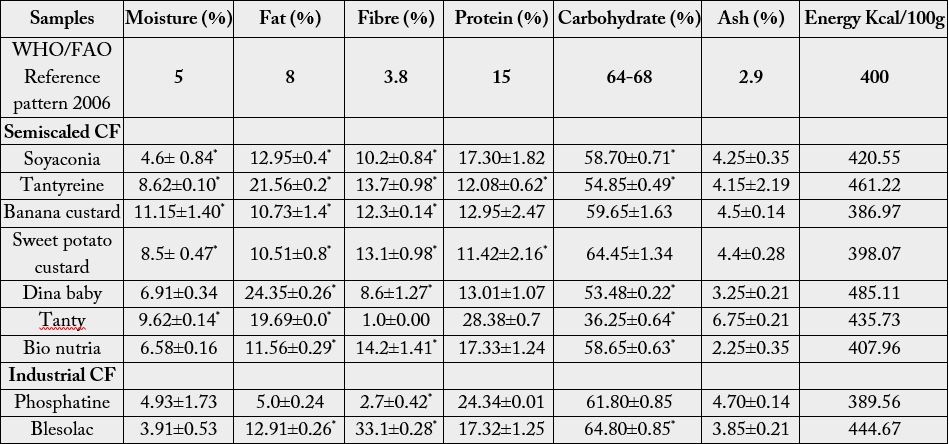
In the same column, values having the * are significantly different at p>0.05 from that of Phosphatine; CF= Complementary food
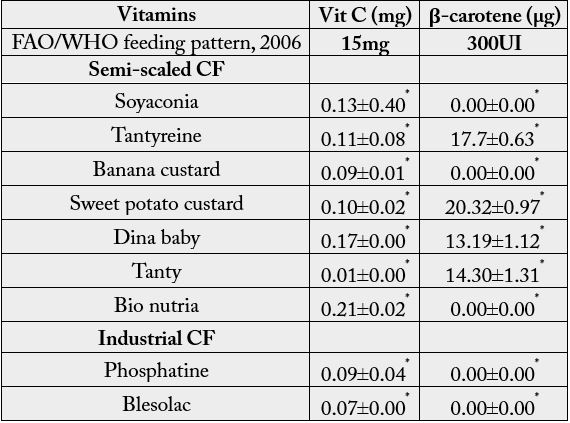
Values with the * in the column are significantly different from that of Phosphatine; CF= Complementary food
The results (Table 1) showed that the highest moisture content is seen with Tanty (9.62%) while Blesolac
recorded the least among (3.91%). The moisture content of Bionutri, Dina Baby, Blesolac, and Soyaconia
samples were not significantly (P>0.05) different from that of the standard (Phosphatine); while Banana
Custard and Tanty, were significantly (P<0.05) higher from that of the standard. On the same line, Sweet
Potato Custard and Tantyreine were also greater (P<0.05) than that of the standard.
The results from the analysis showed that the sample with the highest fat content was Dina baby (24.35%) with the least recorded for Phosphatine (5.0%). When compared with the standard, all the CF samples were significantly different (p>0.05) from that of the standard.
The results for fibre content of the complementary foods indicated that Blesolac had the highest value (33.1%) and Tanty with the least value (1.00%). When compared with the standard (Phosphatine), Tanty was not significantly different (p>0.05) but all the other samples were significantly higher than that of the standard (Phosphatine).
Results for protein content indicated that Tanty (28.38%) had the highest with the lowest value recorded for Tantyreine (12.08%). The protein contents for Bionutri, Dina baby, Blesolac, Tanty and Soyaconia were not significant when compared with the standard (phosphatine), meanwhile the remaining seven samples had a significantly lower value when compared with standard.
Carbohydrate content evaluated revealed that Blesolac had the highest value (64.80%) and tanty recorded the least value (36.25%) Banana Custard and Sweet Potato Custard showed no significant difference (p>0.05) when compared with standard (Phosphatine). Bionutri, and Soyaconia were significantly lower with the standard with Blesolac being significantly higher (p<0.05), whereas the carbohydrate content of all remaining samples was significantly lower (p<0.05) from the standard. Tantyreine, Dina baby, Bionutri, Blesolac, and Tanty had lower (p<0.05) carbohydrates content which were significantly lower in all samples except sweet potato custard and Blesolac when compared to the carbohydrates content recommended by FAO/OMS (2006) [3].
Ash content for the different complementary foods were recorded in which Tanty had the highest value (6.75%) with Bionutri (2.2%) having the least value. The ash content of the remaining samples was not significantly different at p>0.05.
Energy content of the different complementary food samples revealed that all the semi-scaled complementary foods except for sweet potato custard were higher in energy than the standard. The caloric contents of local weaning energy content of the samples which is higher than the recommended value (400 Kcal100g-1) by FOA/OMS Dina Baby (485.11 Kcal100g-1), Soyaconia (420.55Kcal100g-1), Tanty (435.73 Kcal100g-1), Tantyreine (461.22 Kcal/100g), Bio Nutri (407.96 Kcal100g-1) and Blesolac (444.67 Kcal100g-1).
The vitamin C content of the complementary food samples revealed that Bionutri (0.21mg) and the least
value for Tanty (0.01mg). Vitamin C content the remaining samples all showed non-significant difference
from the standard (p>0.05) for Vitamin C content.
The results for β carotene content were also recorded in table 2, with the highest value recorded for Sweet Potato Custard (20.32μg) with the least value (0.002μg) for Soyaconia, Banana Custard, Blesolac, Phosphatine, Bionutri, being non- significantly different from that of the standard (phospatine) at p>0.05 with the other samples being significantly higher than the standard (Phosphatine) at p<0.01. The results obtained for β carotene (ranging from 0.00 - 20.32μg) and C (ranging from 0.01-0.21mg).
Mineral content of the complementary foods is presented in Table 3. Potassium(K) and calcium (Ca) were
the highest minerals present and ranged from 113.78mg (Banana Custard) to 674.43mg (Soyaconia) and
160(Banana Custard) to 2720mg (Dina baby) respectively. The other minerals and their contents were:
Magnesium 19.44mg (banana custard) to 99.63mg (Tantyreine), Zinc 3.84mg (banana custard) to 13.08mg
(Phosphatine), Sodium 38.73mg (Banana Custard) to 117.9mg (Soyaconia), Iron 0.09mg (Banana Custard)
to 47.90mg (Tantyreine). Iron and Zinc had the lowest values in these complementary foods The mineral
analysis results are presented in (Table 3). The amount of sodium, potassium and zinc of the sample Bionutri
(325.13-400.89mg) were in the same range as that of Phosphatine standard but all the complementary food
samples were not comparable to the sodium, potassium and zinc levels of the infant foods recommended by
FAO/WHO (2006). The samples analyzed did not also fall within the recommendation for calcium, zinc
and iron, with only one of them being close (Tanty) to the recommended magnesium level. Potassium levels
(113.78- 925.27mg).
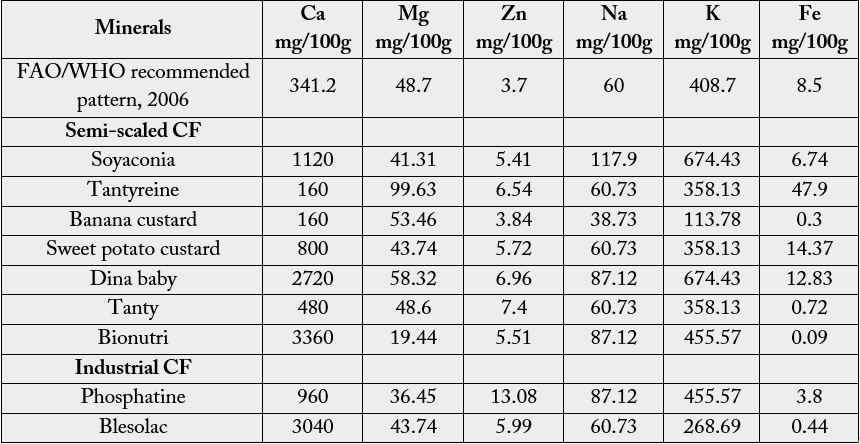
CF= Complementary food
The magnesium contents of the flours analyzed (36.45-99.63 mg). The Mg content is high compared to the standard Phosphatine with a value of 36.45mg.
The sodium contents of the flours analyzed (38.73-117.9mg) are higher than that recommended for children by FAO/WHO (2006).
The Fe contents of the flours tested (0.09-14.47mg) are higher as compared to the recommendation of 8.50mg/100g by FAO/WHO (2006).
The results of microbial analysis were recorded in table 4, with Dina baby recording the highest (2) coliform
count at dilution factor 10-1. Banana Custard and Sweet Potato Custard recorded the highest (108 and 40)
bacterial count at a dilution of 10-2. Phosphatine showed the highest (17) yeast count at a dilution of 10-3.
The results of microbial evaluation (Table 4).
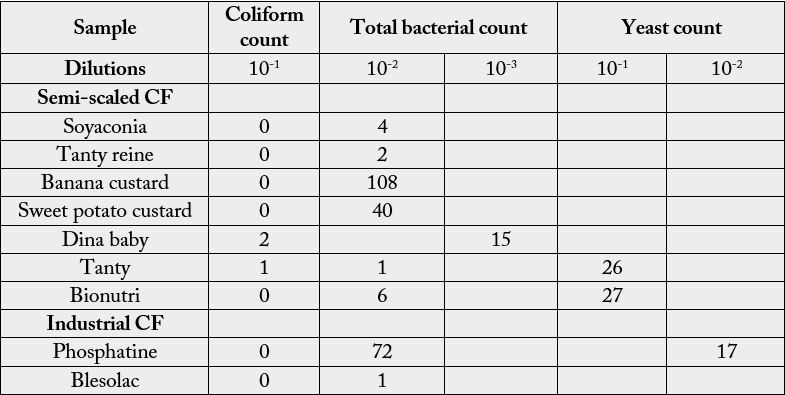
CF= Complementary food
The results of functional properties were presented in Table 5. Foam capacity revealed higest value for
Phosphatine (3.3%) with lowest value for soyaconia and banana custard (2.05%). The foam capacity of
Soyaconia, Tantyreine, Sweet Potatao Custard, Dina baby, Tanty and Bionutri were significantly lower than
that of phosphatine.
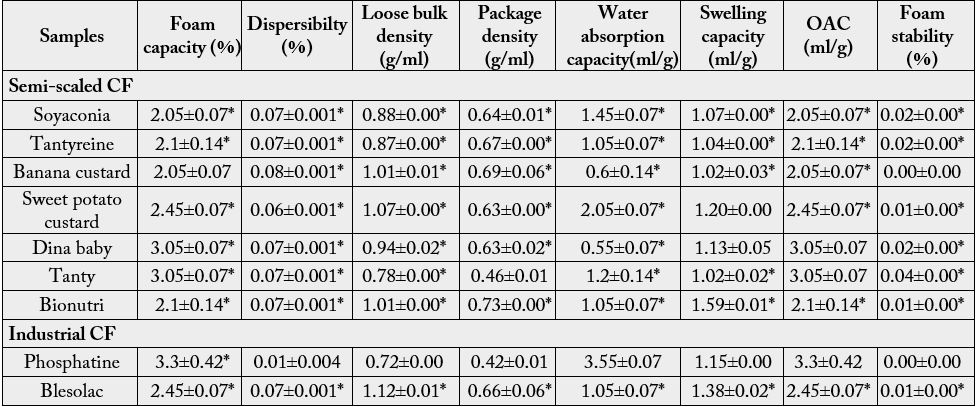
In the same column, values having the * are significantly different at p>0.05 from that of Phosphatine; CF=Complementary food
Dispersibility was highest in Banana Custard (0.08%) and lowest in Phoshatine (0.01%). The difference between the dispersibility results of the samples compared to that of the standard (Phosphatine) was significantly high at p<0.05. The results of foam capacity recorded that the highest value for Phosphatine (3.32%) with the lowest value for Soyaconia and Banana custard (2.05%). Apart from Dina Baby and Tanty, the others had significantly lower foam capacity as compared to the standard (Phosphatine) at P>0.05.
Loose bulk density results were highest for Soyabeans Pap (1.32g/ml) meanwhile the lowest value was recorded for Bionutri and Banana Custard (0.01g/ml). The results showed that loose bulk density of all the samples were significantly higher as compared to the standard (Phosphatine) at p<0.05. Packaged bulk density results revealed that Bio Nutri had the highest value (0.73g/ml) with Phosphatine (0.42g/ ml) recording the lowest score. From the results it is seen that only Tanty is not significantly different from the standard (Phospatine) at p>0.05 meanwhile packaged bulk density of all the other samples had a high significant difference as compared to the standard.
The result of foam stability indicated that Tanty (0.04%) had the highest score whereas Banana custard and Phosphatine recorded none. The results indicated that the foam stability of Blesolac had a significantly higher value than that of the standard (Phosphatine) at p<0.05, whereas that of Bionutri, Dina Baby, Sweet Potato Custard, Tanty, Tantyreine and Soyaconia had a high significantly higher value when compared with the standard at p<0.05. The foam stability of the remaining samples showed no significant difference with standard.
The ability of the flours to absorb water (WAC) (Table 5) revealed the highest score recorded by Phosphatine (3.55ml/g) with the lowest scores revealed by Dina Baby (0.55ml/g). From the results, WAC for all the samples showed a significantly (p<0.05) lower value when compared with standard.
Oil absorption capacity (OAC) recorded the highest score (3.3ml/g) for Phosphatine with the lowest (2.05ml/g) for Soyaconia and banana custard, it is revealed that the OAC of Dina Baby and Tanty had no significant difference when compared with the standard (Phosphatine) at p>0.05 meanwhile the remaining complementary foods showed high significant difference with standard at p<0.05.
Protein solubilities of the complementary foods are summarized in figure 1 and 2. The commercially sold
complementary foods figure 1 shown that Blesolac having two peaks has two proteins with isoelectric PH
of 5 and 8 respectively with Phoshatine which showed 3 bands standing for 3 proteins with isoelectric pH
of 4, 7 and 9.
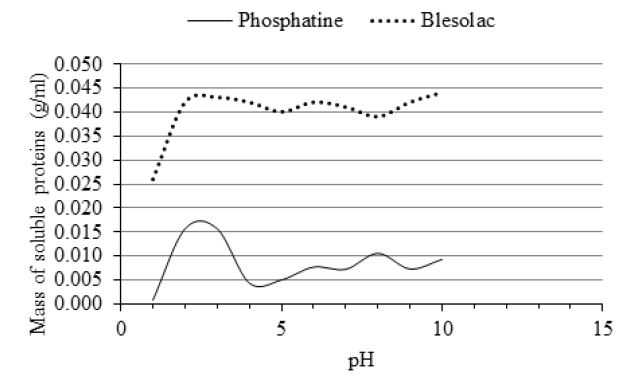
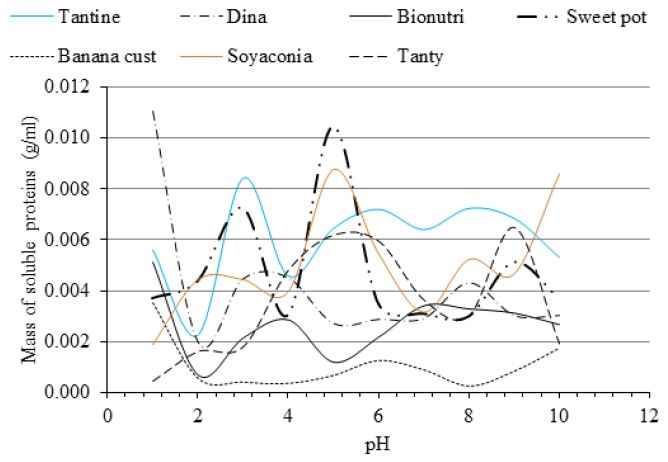
The locally produced complementary foods also revealed different protein peaks as seen in figure 2 revealed that Tantyreine had three peaks (three proteins) with isoelectric pH at 2, 4 and 7. Bionutri had two peaks (two proteins) with isoelectric PH of 2 and 5. Soyaconia showed three peaks (three proteins) with isoelectric pH of 4, 7 and 9. Banana custard had just one peak (one protein) with isoelectric pH of 8. Sweet potato custard had three peaks (three proteins) with isoelectric pH of 4 and 8. Tanty revealed two peaks with isoelectric pH of 3 and 8. Lastly Dina baby presented two peaks with isoelectric pH of 2, 7 and 9. Those with three peaks (Phosphatine, Soyaconia, Tantyreine Sweet Potato Custard) are the second best and lastly, those with two peaks (Blesolac, Tanty and Dina Baby) are the least recommended.
Discussions
Low amount of moisture in food samples is best for prolonging the longitivity of food products while high
amount of moisture in food samples promotes the growth of microorganisms; thus, it can cause the food to
get bad. The amount of moisture in foods is an important factor in determining how prone it is to invasion
by microorganisms. The higher the amount of moisture, the higher the risk of spoilage by microorganisms.
Low moisture content thus denotes low proliferation of microorganisms [10]. The amount of moisture is
used as a quality indicator for complementary foods which is 3-8g.100g-1 [11], thus the highest amount
of moisture observed in sample Tanty is 9.62%. The fact that the was higher value for moisture in local
complementary foods could be due to differences in processing and the preservation.
Fat content of Banana Custard, Sweet Potato Custard, (10.73 and 410.5% respectively) follows what was recommended by Protein Advisory group and the fat content of complementary foods should not exceed 10% (Munasinghe et al., 2013). The amount of fat present in a complementary food has an effect on how long it can last on the shelf. It is due to the fact fat can go through oxidative deterioration, that results in food deterioration. However, increase level of fat mainly saturated fatty acids have been proven to elevate the amount of cholesterol in blood; though, this is not what is observed with unsaturated fats like those found in soy bean and cereals [12].
Locally processed complementary diets with little amount of fiber are so necessary because it aids in the wellbeing of enfants, taking note of the urge they have to take in more in order to achieve the energy required daily. The amount of crude fiber for children’s diet has to be low (Munasinghe et al., 2013), as diets with high amount of fiber causes poor digestion in children. Thus, complementary foods with low amount of fiber were denoted right as good complementary foods. Dietary fiber content was good when compared to that recommended of FAO/OMS (2006) [3].
The amount of protein was lower in the local formulae apart from Blesolac, Bionutri, Soyaconia and Tantyreine formulae compared to the recommendation of FAO/WHO (2006). The values recorded for protein content were similar to value obtained by Tiencheu et al., (2016) [13]. Proteins are necessary, for quick growth and development of children. The low number of proteins recorded for traditional weaning diets have been a main concern for children’s feeding habits. There is a need for formulation as it could act as a feasible way of adding the amount of proteins in local sorghum and maize based complementary diets.
The fact that the carbohydrate content of the complementary foods was in close range to that of the carbohydrates content recommended by FAO/WHO (2006) could be assigned to the fact that most of them are made from carbohydrate sources. According to Munasinghe et al., (2013) the ash content of weaning food should not exceed 5%. Although, in this experimental study, all values are lower but were in acceptable limits as those required by FAO/WHO (2006). This could be a result of the fact that most of these complementary foods are not enhanced with many of mineral ingredients. The caloric contents of most of the complementary diet samples were higher than the required value (400 Kcal100g-1) by FOA/WHO. This high caloric value could be due to their high amount of carbohydrate and also their high fat content as compared to Sweet Potatao Custard and Banana Custard, which had lower caloric values. These results were not in line with that of Asoba et al., (2018) [14]. These results were lower than the results reported by Kanu et al., (2009) [15] who also studied production and evaluation of breakfast cereal-based porridge mixed with sesame and pigeon peas for adults.
Microbiological evaluation was carried out on complementary foods to ascertain their wholesomeness for consumption. In this evaluation, the amount of Coliform was in recommended limits (Table 4) but yeast count and total bacterial load were not. Following the accepted by the UK Food Protection Agency and Food Standard Australia New Zealand (FSANZ), desired Total Plate Count (TPC) for cereal flour mixtures is < 107 CFU/g and coliform count is < 3 CFU/g. The analyzed semi-scaled and commercial complementary diets were in the desired range. The spoilage of many foods will actually take place when the bacteria count reaches 10-100 m/g of product. The international microbiological standard desires a bacteria infestation limit of < 106 CFU.mL-1 for food. The high bacteria load noted in locally made complementary foods like Banana Custard may be as a result of poor sanitary conditions of vendor and a lack of good production practices during the food processing. These results are different from that of Asoba et al., (2018) [14] who presented lower values for total bacterial count and this could be explained by the fact that our homemade complementary foods could have been self-contaminated by the mothers during preparing either by using dirty hands or dirty kitchen equipment.
The results obtained for β carotene (ranging from 0.00 - 20.32μg) and C (ranging from 0.001-0.21mg) are not in line with the higher values observed for complementary foods processed from cooked banana, fortified with cowpea and peanut as observed by Bassey et al., (2013) [16]. These results prove that these complementary diets might not be used as an appropriate source of vitamins especially vitamins A and C which is essential for visual and immune system development in infant and children. These results are different from that of Asoba et al., (2018) [14] who presented higher values and this could be due to the fact that these vitamins are affected by production process as they are not thermo-stable.
Minerals are vital for health. In this study the mineral content in most of the complementary foods including the control phosphatine did not meet the recommendation of FAO/OMS (2006), except for iron, thus they can protect against iron deficiency anemia. Also, the semi-scaled complementary food, Tanty showed good amounts of all the five minerals analyzed except for Fe. Very low amount of iron was observed in all the other complementary food samples and iron deficiency can result in anemia.
For the functional properties, the differences showed in water absorption among the flours may be due to different protein concentration, their degree of interaction with water and their conformational characteristics (McWatters et al., 2003). On the other hand, McWatters et al., (2003) stated that lower water absorption capacity is caused by less availability of polar amino acids in flours. This effect is most likely due to lose interaction of amylose and amylopectin in the native granules of starch and softer interaction enhances maintenance of the granules structure [17]. This result revealed that the composite flours had better gelling property. The ability of a flour to absorb water is necessary in bulking and consistency of product and also in baking applications [18].
Bulk density (loose bulk density and packaged density) presents an indication of the relative volume of packaging material necessary and high bulk density is a better physical factor when evaluating the mixing quality of a particulate matter Achinewhu et al., (1998) [19]. The bulk density is a view of the amount the flour samples can take, if left to rest directly on one another. The density of processed products indicates the characteristics of its container or package product density indicates the number and strength of packaging material, texture or mouth feel (Lewis,1992). According to Basman et al., (2003) [20], higher bulk density is needed for greater ease of dispersibility of flours. Also, high bulk density reduces the caloric and amount of nutrients per feed of children which can cause poor growth. However, low bulk density would be a good factor in the formulation of complementary foods (Ugwu and Ukpabi, 2002). The low bulk density values observed could thus be good in the preparation of complementary food formulas.
Oil absorption capacity (OAC) has been denoted to be due to physical entrapment of oil and the binding of fat to the polar chains of proteins. Kinsella (1976) [7] observed that more water hating proteins show greater binding of lipids, this indicates that non-polar amino acids side chains bind the paraffin chains of fats. The lower OAC of the formulated blends (Soyaconia and Banana custard) could be as a result of the fact that Phosphatine (with a greater OAC) had more available non-polar side chains in its protein molecules than Soyaconia, Banana custard and Bionutri. This implies that Phosphatine will be able to hold more flavour and most likely have a nicer mouth feel as oppose to the other complementary diets.
Swelling power refers to the expansion accompanying spontaneous uptake of solvent while solubility index (SI) is the number of water-soluble solids per unit weight of the sample. According to Kinsella (1976) [7], Swelling causes changes in hydrodynamic properties of the food thus impacting characteristics such as body, thickening and increase in viscosity to foods.
Protein solubility denotes the number of soluble proteins present in a sample and also their associated isoelectric points. Therefore, a sample with the highest number of peaks denotes more soluble proteins with the corresponding throughs revealing the associated isoelectric points of the proteins [21-29].
Conclusion
When nutritional evaluation of these local weaning foods was carried out, it was observed that amount of
moisture in Phosphatine was within the required limits. The amount of carbohydrate in the complementary
food Sweet Potato Custard was in the acceptable limit. Potassium and calcium were the highest minerals
present in the local complementary foods with one of the samples Tanty having the acceptable value for
Magnesium mineral. The amount of both vitamins which were analyzed were very low. The functional
properties of the complementary diets showed a significant difference when compared to that of Phosphatine.
It was also observed during the microbiological evaluation that, the complementary foods analyzed fell in the
accepted limits of food protection free from bacteria and fungi. However, the bacteria load was a little high
which could have resulted from sanitary conditions. Thus, it could be seen that most of the complementary
diets are inadequate in or more nutrients and need fortification in order to serve as a good complementary
food for children.
Acknowledgements
We are grateful to the laboratory of Nutrition and Nutritional Biochemistry, Department of Biochemistry,
University of Yaounde 1 for supporting this study through our supervisor/ Mentors; Prof Julius Oben and
Prof. Azantsa Kingue. Authors are also thankful to Islamic Development Bank Postdoctoral Programme
(IsDB) for their financial life stipend in support of this research work granted to Dr. Tiencheu Bernard. We
are also very grateful to mothers that give their consent for data collection to undertake this study.
Conflict of Interest
The authors declare that they have no known competing financial interests or personal relationships that
could have appeared to influence the work reported in this paper.
Bibliography

Hi!
We're here to answer your questions!
Send us a message via Whatsapp, and we'll reply the moment we're available!